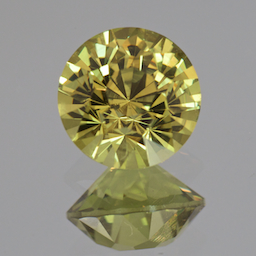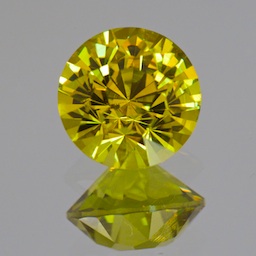by Richard W. Wise, G.G.
©2011
You Just Can’t Hide Those Lying Eyes:
In my first post on this subject, I made the point that making a purchasing decision or merely comparing prices by comparing images is fraught with difficulty. Photoshop and other similar programs are a good part of the reason why. The two images to the left illustrate the point. Image A is a custom cut Mali garnet. Based on the image, the stone appears to be a slightly greenish (10% yellow light toned garnet of medium saturation, not bright but not overly dull with a slight gray mask.
In Image B of the same stone, the original image has been altered by a simple tweak of the Saturation Enhancement Tool in Photoshop. The green secondary hue now appears more prominent, perhaps 15-20%. The big change, however is in the level of saturation. The color must now be described as vivid effectively doubling the value of the stone. The only hint that this is the same image is that the background in image A is slightly cooler (grayer) than the background in image B. However, if the photographer simply took two shots under the same lighting he could easily disguise that fact. Backgrounds can also be removed or replaced with a uniform black. Assuming that these two images appeared at similar prices on separate websites, an online bargain hunter would wrongly conclude that the owner of the stone labeled image B was offering his goods at a much more favorable price.
Approaching the Pinnacle of Perfection, Small bumps in Quality Equal Big Bumps in Price.
In low quality commercial grade gemstones, small differences is quality will not make a great difference in price. However, as quality nears theoretical perfection the importance of smaller differences is magnified. In the stratosphere of gemstone quality, small differences can make for very large price differentials. Lets take an example that everyone knows, the D flawless diamond. I chose this example because diamonds are very precisely graded using an internationally accepted grading system. According to The Guide a well respected industry publication, the current wholesale price of a 1.00 carat D-IF is 31% higher than the very next color grade, E-IF, compared by clarity grade, (D-Fl vs D-VVS1) the spread is slightly less, about 29%. A similar comparison between diamonds with a color grade of L and O shows only a few hundred dollars separating the two grades. These differences will not show up in an online image.
In colored gemstones these same percentages apply and the grading equation becomes much more complex. Colorless diamonds are graded based on slight tonal variations of yellow. Color, any color, breaks down into two additional factors, hue and saturation which must be added to tone in the quality equation. In nature there are few pure hues. The hue of a gemstone is composed of primary, secondary and sometimes tertiary components, a top color ruby for example, may be 75% red, 15% purple and 10% orange. A blue sapphire with 10% (or less) green secondary hue which will likely not be visible in an online image will sell at a dramatically lower price than a stone with a pure or slightly purplish blue hue. Similarly, an emerald that is 75% green with a 10-15% secondary blue hue can sell for double the price of a slightly yellowish stone. These slight differences in hue do not show up even in professional images. This makes online comparison between two images very deceptive and of little or no value.
The Value of Images:
Online images are of some value. As a professional, I never use images to determine which stones I will buy though sometimes they can identify a stone that I will not buy. It is usually possible to tell something about the clarity and cut of a given gem by viewing the image. Both come with caveats.
Online Images are Many Times the Size of The Stone; so are the inclusions:
The Mali garnet at left weighs approximately one carat. That means the stone is somewhere in the range of 6 mm in diameter. The image shown is 38mm, 6.33 times larger. Many gems that are eye-flawless will appear visibly included (flawed). In colored gemstones, the eye standard replaces the loupe standard, what the eye sees is what is important, magnification doesn’t effect price. In most varieties of colored gemstones, the difference between eye-clean and visibly included is dramatic. It is similar to the difference between a diamond graded flawless and another graded SI2.
In some cases the image will actually distort what the eye sees. Award winning gem photographer, Robert Weldon, makes the point that due to the limits of depth of field, the camera’s lens will compress inclusions into a single plane increasing the prominence of the inclusions in the image. This compression can lead to particular difficulties when trying to accurately render images of expensive type II and III gemstones such as emerald where the difference in value between an eye-clean gem and one with eye visible inclusions will be dramatic. Online images are normally in j.peg format. This format is created, Weldon points out, by subtracting information in the original high resolution image.
Images can be useful in evaluating cut but bear in mind that the visual performance in a gem depends upon lighting. A well lighted gemstone may appear to perform better than one that is less well lit. The lighting environment is not visible, multiple light sources of the type normally used in photography can mask real deficiencies in cut.
Color and Lighting:
In the good old days, there were two types of light; the sun and light from a natural flame, a fire or a candle. This, as I point out elsewhere, is the source of the legendary “ruby red” alexandrite. When that gem was discovered in the mid nineteenth century, incandescent light was supplied by a candle and candlelight is distinctly reddish—after the invention of the light bulb, the ruby red alexandrite became distinctly purple because that light source is yellowish. With today’s technology, it is possible to virtually cherry pick a lighting environment that is strong in a given color. You can light sapphires with blue light, rubies with red. Again the light source is not visible—so how would you know until your gem arrives in the mail.


